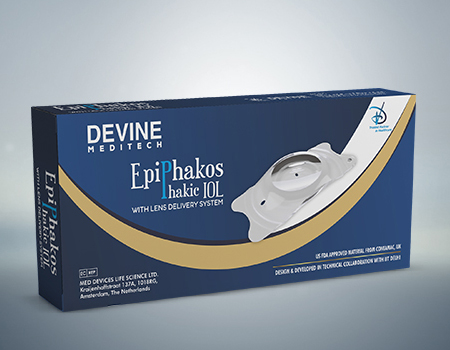Have you ever wondered what a "Phakic IOL" is and how it can benefit you? You may have heard about it in conversations about alternatives to traditional contacts or glasses. One kind of intraocular lens that may be placed straight into the eye without removing the natural lens is the Phakic IOL. The Phakic IOLs are inserted either behind or in front of the iris during Phakic surgery.
The Phakic IOLs by Devine Meditech are placed beneath the iris, preserving the accommodation in the lenses and preventing any damage to the patient's natural lens. For those whose high refractive flaws cannot be sufficiently adjusted with glasses or contact lenses, it is quite beneficial.
Devine Meditech produces the greatest Phakic IOLs in India, and their products are a huge value to the ophthalmology industry.

The ideal candidate has a steady refractive error prescription and is between the ages of 18 and 40. The optometrist must accurately evaluate the eyes in order to determine eligibility.
Phakic IOLs are generally suitable for those with:
1. Myopia (Nearsightedness): Particularly those with nearsightedness that is so severe that it is outside the scope of LASIK repair.
2. Hyperopia (Farsightedness): People who are farsighted have trouble seeing close objects.
3. Astigmatism: Astigmatism can be caused by an irregularly curved IA cornea.
1. Clear Vision: Phakic IOLs improve vision quality since the majority of patients who have this operation tend be gifted with a better, sharper vision than those who get LASIK.
2. Reversibility: Without altering the natural lens, the process may be undone if necessary. For people who might not desire permanent modifications, this is a flexible option.
3. Preservation of Accommodation: One clear benefit for children is that phakic IOLs do not compromise for nearsightedness, in contrast to standard IOLs.
4. Minimal Recovery Time: Most patients heal quickly and may return to work or studies in a few days.
1. Risks of operation: Infection, inflammation, and eye injury are possible outcomes of any operation.
2. Long-Term Implications: Research is already being done to ascertain the safety and long-term effects of Phakic IOLs, despite many patients recovering rather well.
3. Cost: Most patients must carefully weigh the related costs because insurance may not cover Phakic IOLs.
1. Preoperative Evaluation: A thorough examination of the eyes to assess their condition and vision.
2. Procedure: Under local anaesthesia, the surgeon makes a tiny incision in the operating room and inserts the Phakic IOL into the eye.
3. Postoperative Follow-up Care: Analysis is required to assess visual recovery after a while.
For people who want to completely avoid using glasses or contact lenses, phakic IOLs offer a viable alternative. More people can experience the freedom and clarity they desire as surgical methods and technology improve. If you plan to choose this option, you should consult an ophthalmologist who can assist you in selecting the technique that best meets your unique demands and eyesight requirements. Always keep an eye out for Phakic IOLs from reputable producers such as Devine Meditech, who have established a solid reputation in the market for producing a wide range of high-quality goods.